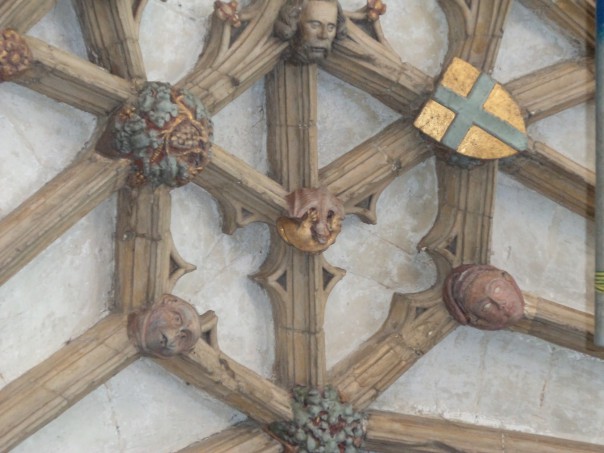The issue of migration in the early modern period with regard to Kent was not an explicit theme in the various papers given at the ‘New Developments’ conference last Saturday. However it was there, whether it was small-scale movements of people across the county, the pull of London, the arrival of individuals and groups as economic migrants or religious refugees from the Low Countries, in particular, or the departure of Kentish men and women, often with other household members to the New World. Such movements may be viewed as especially important in counties like Kent that can in some ways be seen as meeting places of people and ideas, points of inter-section where insular and continental influences jostle for position, even supremacy whether in matters of language, customs and ethnicity.
Cloister bosses from Canterbury Cathedral
I mentioned similar ideas a couple of weeks ago when considering Richard Eales’ lecture on the Normans in Kent (and England), but in a week when the candidates of all political persuasions are discussing immigration, as well as, of course, the economy, national debt, education, health and housing, it may be worth mentioning it again here. Not least because I heard Jonathan Butchers give a talk on ‘The Jews in Canterbury’ that, as well as providing some interesting snap-shots of Jewish individuals both before Edward I’s expulsion of them in 1290 and after their return under Oliver Cromwell in the mid-17th century, underlined some of the debates surrounding the topic including integration, separateness, stereotyping and fears over competition. However to end this short post before Easter, I thought I might mention a particularly rich documentary source that I am currently using at the cathedral archives to explore migration in relation to those who sought to trade independently in Canterbury during the later Middle Ages, but were below the freemen. Although, as you would expect, it looks as though most had not travelled far, and some hardly lasted longer than a year as independent traders or artisans in the city, it is worth highlighting the arrival of an interesting group from the Low Countries, as well as the presence of others who seemingly came, possibly in stages, from other parts of the British Isles. But I’ll come back to this another time; and so Happy Easter to all who happen to read this.
 Centre for Kent History and Heritage
Centre for Kent History and Heritage Sheila Sweetinburgh
Sheila Sweetinburgh 1100
1100


